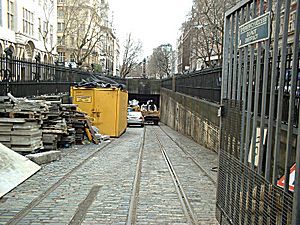Conduit current collection facts for kids
Conduit current collection is a special way for electric trams to get their power. Instead of using overhead wires that hang above the street, the electricity comes from a hidden channel, or "conduit," built right under the road surface. This system was used in some big cities because it kept the streets looking neat, without lots of wires overhead.
Contents
How Conduit Power Works
Imagine a narrow slot, about an inch wide, running down the middle of the tram tracks. This slot is the opening to the "conduit" – a small tunnel or channel built underground. Inside this channel, there are two metal rails or "conductors." These conductors carry the electric power, one for the positive current and one for the negative.
The tram itself has a special device called a "plow" or "collector shoe." This plow is a long, flat arm that extends down from the tram, through the slot in the road, and into the underground conduit. At the end of the plow, there are two metal contact shoes. These shoes slide along the two electric conductors inside the conduit, picking up the electricity the tram needs to move.
The electricity then travels up the plow to the tram's motors, making it go. After the electricity powers the tram, it returns to the second conductor in the conduit, completing the circuit.
Why Use Conduit Power?
Conduit current collection was mostly used in busy city centers, like parts of London, New York City, and Washington, D.C., especially in the late 1800s and early 1900s. The main reason was appearance. City planners and residents often disliked the look of overhead wires, which they thought made the streets look cluttered and messy. Conduit systems offered a way to run electric trams without visible wires.
Another reason was safety. With no overhead wires, there was no risk of wires breaking or falling, which could be dangerous. It also meant that tall vehicles, like fire engines or double-decker buses, could pass freely without hitting wires.
Challenges of Conduit Systems
While conduit systems looked good, they had some big drawbacks:
- Costly to Build: Digging and building the underground conduit channels was very expensive and took a lot of work. It was much pricier than simply putting up poles and overhead wires.
- Maintenance Issues: The underground channels could easily fill with dirt, mud, snow, or even water. This could cause problems with the electrical contacts or even short circuits. Keeping them clean was a constant challenge.
- Switching Tracks: When trams needed to change tracks or switch directions, the underground conduit system made it more complicated than with overhead wires.
- Limited Use: Because of these challenges, conduit systems were only used in a few specific places where the benefits (like appearance) outweighed the high costs and difficulties. Most tram systems around the world chose overhead wires because they were simpler and cheaper.
Today, most electric trams use overhead wires or other modern power systems. However, the conduit system remains an interesting part of tram history, showing how engineers tried to solve problems in clever ways.
Other pages
- Ground-level power supply
- Kingsway tramway subway
- Railway electrification system
- Tramway tracks
- Third rail
Images for kids
-
A conduit tramcar from Blackpool, on display at the National Tramway Museum




